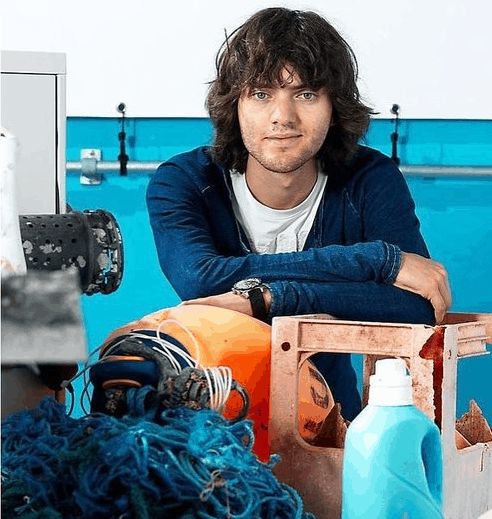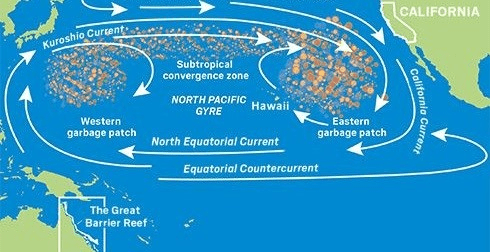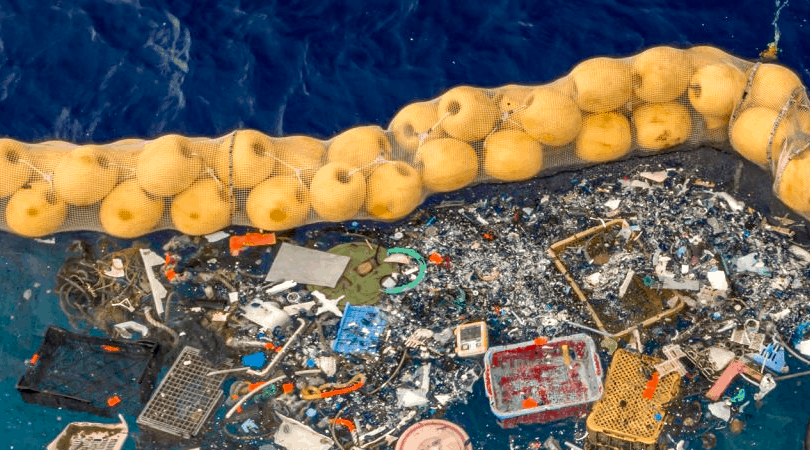The Ocean Clean Up Project hopes to rid the ocean of plastic by 2050, and a fleet of floating booms may be one answer to the pollution in our oceans. Designed by Dutch scientists, a prototype of this giant free-floating boom has now successfully cleaned up plastic and other garbage from the open ocean. It’s just a start, but one that will hopefully lead to a global solution.
The Ocean Clean Up Project, a Dutch non-profit organization, announced on October 2, 2019, that it’s latest prototype system, named System 001/B had successfully captured and collected plastic trash from the ocean. After a year of testing, engineers from the non-profit have developed a self-contained system that uses the natural waves and forces of the ocean to catch and clean up free-floating debris in the waters. The device can gather large, easily visible pieces of plastic debris, as well as larger “ghost nets” left from commercial fishing. The engineering team was happily surprised to find that the latest prototype also captured microplastics as small as 1mm.
The system was designed to clean up what has become an island of floating garbage in the Pacific Ocean. The floating pile of trash is three times the size of France and is now being called the Great Pacific Garbage Patch.

The designer and creator of the Ocean Cleanup Project, Boyan Slat, recently tweeted the boom had encircled and picked up debris from this floating debris pile. The boom can skim the water and collect garbage ranging in size from discarded fishing nets and car wheels to tiny pieces of plastics.
Slat posted a photo of the collected garbage, which included a wheel from a car. He tweeted, “Our ocean cleanup system is now finally catching plastic, from one-ton ghost nets to tiny microplastics! Also, anyone missing a wheel?”
Accumulated plastic in the world’s oceans is a growing problem.
The massive amount of accumulated garbage in our oceans is a problem around the world. 8 metric tonnes of plastic waste flows into the oceans from beaches. Approximately 600,000 to 800,000 metric tonnes of fishing gear is discarded or lost to the ocean every year. Projections show that the amount of plastic in the ocean could quadruple by mid-century if the problem is not addressed.

According to The Ocean Clean Up Project website, nearly half the plastic in the Great Pacific Garbage Patch is from the 1990s or even older. Research has shown that the highest mass of plastic is currently in the larger pieces of debris. By cleaning up the plastic while it is mostly still significant, the Ocean Clean Up Project hopes to prevent it from breaking down into dangerous microplastics.
New technologies are being designed to clean up ocean plastics.
For the last five years, researchers at The Ocean Clean Up project have been working to study and understand the full scope of the problem of ocean plastic pollution to design effective advanced technologies to solve the problem. The non-profit, founded in 2013 by Boyan Slat, now employs approximately 90 engineers and researchers and is headquartered in Rotterdam, the Netherlands.
Engineers from the project have created a cleanup system that consists of a plastic boom floating on the surface of the ocean with a 3 meter deep (10ft) screen hanging below it. The screen will collect some of the pieces of plastic and trash without harming marine life below it.
The goal is for this giant C shaped floating boom to eventually collect 50% of the debris in the patch over five years. The system is driven by wind and waves throughout the debris field.
Satellite transmitters and sensors on the device communicate the location of the system to a boat or vessel that will travel out to pick up the trash every few months.
Design modifications lead to successful plastics cleanup.
The process of designing the system came with challenges. The original project began in 2013 and has been through several revisions. During an earlier four-month trial, the boom broke into pieces so that no trash was collected. After that equipment failure, design changes included the addition of what is called a “parachute anchor,” which slows the movement of the boom and cleanup system through the seas. This allows lighter and faster moving plastics floating in the ocean to catch up and be captured by the system.
Another design modification was to increase the size of the cork line that helps to hold the rubbish in place. With this new cork line, overtopping is a minimal problem, and the system works to capture the plastics.
In June, after the design modifications were completed, the cleanup system was launched from Vancouver, British Columbia, for the latest successful trial. The system successfully picked up plastic debris, even as small as 1mm, and other trash. Slat hopes that eventually, in the final design, the cleanup system will be able to collect as much as half of all the debris in the Great Pacific Garbage Patch.
Project to rid the ocean of plastics continues.
At a press conference in Rotterdam, the Netherlands, on October 2, 2019, Slat remarked, “We are now catching plastics … After beginning this journey seven years ago, this first year of testing in the unforgivable environment of the high seas strongly indicates that our vision is attainable and that the beginning of our mission to rid the ocean of plastic garbage, which has accumulated for decades, is within our sights.”
“We now have a self-contained system in the Great Pacific Garbage Patch that is using the natural forces of the ocean to catch and concentrate plastics passively… This now gives us sufficient confidence in the general concept to keep going on this project,” Slat continued at the press conference.
The plan is to bring the plastics collected to shore in December of 2019 for recycling. The project hopes that this unique plastic rubbish will create a premium market for items made from plastic reclaimed from the sea. Engineers with the Ocean Cleanup are working with partners to find a way to reuse the plastic recovered from the ocean, either converting it back into raw material or durable, useful products.
If money can be made by selling the plastics, it will help to finance the project. A final problem to solve is the cost of using a trawler to retrieve the collected plastics. Slat is hopeful that the costs can be covered. “I think in a few years when we have the full-scale fleet out there, I think it should be possible to cover the operational cost of the cleanup operation using the plastic harvested,” Slat said.
More work is needed before the project is ready to be fully launched and operational. The Ocean Cleanup will now begin work on a full-scale cleanup system, System 002. Engineers plan to make the device larger and more durable so it can gather and retain rubbish for a year or longer before vessels arrive to retrieve and collect the plastics. Further testing and design modifications will continue.
The Ocean Clean Up Project is hopeful that this floating clean up system, combined with efforts toward reducing plastic use and disposal on land, will start the world on the path toward a plastic-free ocean by 2050.

